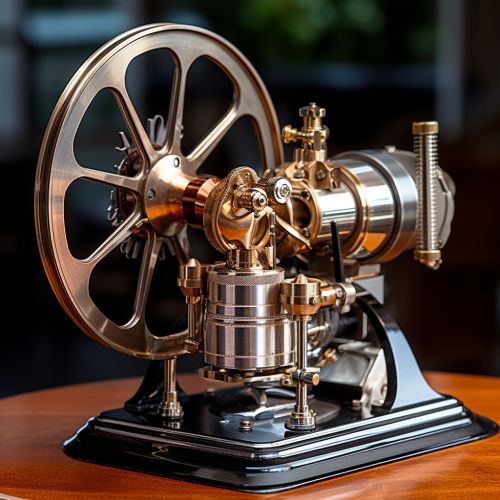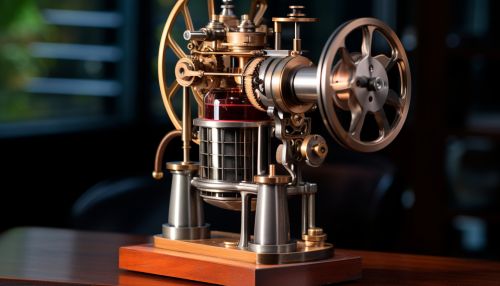Stirling Engine
Overview
The Stirling engine is a type of heat engine that operates by cyclic compression and expansion of air or other gas, known as the working fluid, at different temperature levels. The heat energy produced is then converted into mechanical work. Unlike the internal-combustion engine, the Stirling engine contains a fixed amount of gas that is transferred back and forth between hot and cold heat exchangers.


History
The Stirling engine was invented and patented by Robert Stirling in 1816. It followed earlier attempts at making an air engine but was probably the first put to practical use when, in 1818, an engine built by Stirling was employed pumping water in a quarry. The main subject of Stirling's original patent was a heat exchanger, which he called an "economiser" for its enhancement of fuel economy in industrial processes. The patent also described in detail the employment of one form of the economiser in his unique closed-cycle air engine design.
Working Principle
The Stirling engine follows a thermodynamic cycle known as the Stirling cycle, which is different from that of the internal combustion engine. This cycle uses two isochoric processes and two isothermal processes. The working gas in a Stirling engine is sealed within the engine, and the engine works on the principle of heating and cooling the gas. The gas is heated in the expansion space and cooled in the compression space. The gas is then moved between the two spaces by the displacer, allowing the engine to convert heat energy into mechanical work.
Types of Stirling Engines
There are three main types of Stirling engines, each differing in the way they transfer the working fluid between the hot and cold heat exchangers.
Alpha Stirling
The Alpha Stirling has two power pistons in separate cylinders, one hot and one cold. The hot cylinder is situated inside the high temperature heat exchanger and the cold cylinder is situated inside the low temperature heat exchanger. This engine has a high power-to-volume ratio but has technical issues due to the usually high temperature of the hot piston and the durability of its seals.
Beta Stirling
The Beta Stirling has a single power piston arranged within the same cylinder on a separate displacer piston. The displacer piston is used to move the working gas from the hot heat exchanger to the cold heat exchanger. When the working gas is in the hot heat exchanger, it expands and pushes the power piston. When it is in the cold heat exchanger, the gas contracts and the power piston moves back to its original position.
Gamma Stirling
The Gamma Stirling is simply a Beta Stirling with the power piston mounted in a separate cylinder alongside the displacer piston cylinder, but still connected to the same flywheel. This configuration produces a lower compression ratio but is mechanically simpler and often used in multi-cylinder Stirling engines.
Applications
Stirling engines have a wide range of applications. They are used in some combined heat and power units, where they generate electricity and provide space and water heating. They are also used in solar power generation, where they are driven by concentrated sunlight, and in nuclear power systems. Stirling engines can also be used in cooling systems, such as cryocoolers, and in submarines and other marine vehicles.
Advantages and Disadvantages
Stirling engines have several advantages over other types of engines. They are highly efficient, quiet, and capable of using almost any heat source. The heat is applied externally, which makes them easy to fuel and reduces the risk of explosion. However, they also have some disadvantages. They have a relatively low power-to-weight ratio, which makes them unsuitable for many transport applications. They also require heat exchangers, which can be difficult to design and manufacture.
